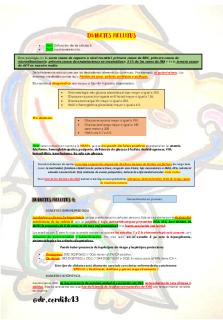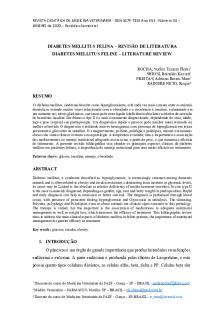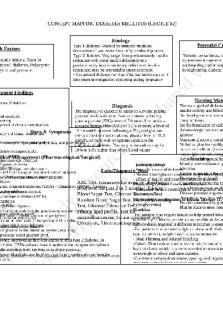NUR213. Diabetes Mellitus + complications PDF

| Title | NUR213. Diabetes Mellitus + complications |
|---|---|
| Author | Nursing Student |
| Course | Nursing Science Iii |
| Institution | Dutchess Community College |
| Pages | 4 |
| File Size | 244.9 KB |
| File Type | |
| Total Downloads | 89 |
| Total Views | 161 |
Summary
Diabetes M...
Description
Diabetes Mellitus ENDOCRINE DISORDER of the Pancreas:
*INSULIN THERAPY*Type 1/2
Type 1 “Juvenile” Insulin dependent-Requires Exogenous Insulin therapy for blood glucose control Type 2 -Insulin therapy is indicated for Type 2 DM when Blood sugar goals cannot be met with the use of 2-3 different antidiabetic drugs 4 S’s: -Sepsis or infection or Sick (#1 cause) -Stress (surgery, hospital stay) -Skip a dose of insulin -Steroids (prednisone)
Teaching: Moderate exercise like walking helps regulate blood glucose levelslowers insulin requirements Onset, peak + duration 1. Eat FOOD during PEAK peak=plates #1 way to KILL patients is NOT to give PLATEof FOOD @ PEAK 2. S+SX HYPOglycemia 3. NO peak NO mix “Long Acting”NEED 2 SEPARATE SYRINGES 4. ONLY Regular insulin is Ready to go IV Right in VEIN 5. Draw up CLOUDYCLEAR “You want CLEAR days before CLOUDY ones” RegularNPH 6. ROTATE Injection sites every 2-3 weeks BEST IN ABDOMEN (Near umbilicus) 7. DKA Type 1 “Sick Days” Diabetic Ketoacidosis Yes give insulin w/o food even if nauseous + NOT eating Monitor glucose closely
Insulin stimulates cellular glucose uptake Transport of glucose into target cells blood glucose Usual starting dose for Insulin is between 0.5-1 unit/kg/day
PEAK =
*ORAL TREATMENT *Type 2
Diabetes Mellitus ENDOCRINE DISORDER of the Pancreas: Type 2 Pancreas is NOT DEAD just OVERWORKED
Diet + Exercise Have failed2-3 Oral hypoglycemic meds Insulin (Last line) -Diet, regular exercise, stress management changes are made BEFORE medication therapy -Antidiabetic oral meds are not a substitute for diet modification + exercise -Insulin therapy is indicated for Type 2 DM when Blood sugar goals cannot be met with the use of 2-3 different antidiabetic drugs Teaching: Never take with: NO iron, NO calcium, NO antacids (tums, Rolaids)BLOCKS absorption in stomach NO alcohol (lowers sugar) + NO liver disease (Cirrhosis + hepatitis)drugs can be !!!TOXIC TO LIVER!!!
Insulin stimulators- Triggers pancreas to release insulin Second-Generation Sulfonylurea Agents Glipizide (Glucotrol) + Glyburide (Diabeta, Micronose) + Glimepiride (Amaryl) -“Heart can DIE”Very BAD for: CHF + MI hx “SLOW position changes” headache -PhotosensitivitySUN BURNS= sunscreen + protective clothing **TOXIC to elderly **TOXIC- Renal + Liver -Minimal chance of hypoglycemic events (AVOID alcohol-hypoglycemia) -Massive weight gain Meglitinide Analogs Repoglinide (Prandin) Nateglinide (Starlix) Take w/in 30min of eating Goof for patients w/ erratic eating patterns **TOXIC to elderly **TOXIC- Renal + Liver BiguanidesLower blood glucose level by Inhibiting liver glucose production Decrease intestinal absorption of glucose Increase insulin sensitivity Metformin (Glucophage) -Minimal chance for hypoglycemia -Massive Weight gain”Met 4 Men is 4 BIG dudes” **Major Kidney + Liver TOXIC -Lactic Acidosis: NO alcohol -STOP 48hrs before + after cath STOP ON DAY OR SURGERY IV contrast Kills kidneysLactic Acidosis **1st choice for elderly because not toxic to them like Glipizide
DPP-4 Inhibitors- Prevents the enzyme DPP-4 from breaking down the natural gut hormones (GLP-1 + GIP) which then allows these natural substances to work with insulin to lower glucagon secretion from the pancreas, leading to reduced liver glucose production. These oral drugs reduce blood glucose levels by delaying gastric emptying, slowing the rate of nutrient absorption into the blood + reducing food intake Alogliptin (Nesina) Linagliptin (Tradjenta) Saxaglyptin (Onglyza) Sitagliptin (Januvia) Only works when you eatit doesn’t cause hypoglycemia S.E- URI, UTI + Headache
Amylin Analog- Similar to Amylin; a naturally occurring hormone from beta cells in the pancreas that is co-secreted w/ insulin + lowers BG by decreasing endogenous glucagon, delaying gastric emptying + triggering satiety Prumlitide (Symlin)
Sodium- glucose Cotransport Inhibitors- Lower BG by preventing kidney reabsorption of glucose + sodium that was filtered from the blood into the urine. This filtered glucose is excreted in the urine rather then moved back into blood Canagliflozin (Invokana) Dapagliflozin (Farxiga) Empagliflozin (Jardiance) Combination Products- Many fixed combinations of oral drugs are available. Each ingredient has the same mechanism of action + nursing implications as the parent class drug. When a drug that has the side effect of hypoglycemia is combined w/ a drug that does not alone produce hypoglycemia, the development is still very much a risk for the combination agent
Insulin sensitizersLower blood glucose levels by Inhibiting/decrease glucose Liver production Decrease intestinal absorption Increase insulin sensitivity of receptors Reduce insulin resistance
Thiazolidinediones (TZD) Pioglitazone (Actos) + Rosiglitazone (Avandia) Black Box warning -“ONE DEAD heart” -NO heart failure patients Risk for heart failure Heavy fluid retentionpitting edema + crackles + SOB + rapid weight gain **TOXIC- Heart + LiverNO liver failure patients (Cirrhosis + Liver failure) -Pink frothy sputum
Alpha-Glucosidase Inhibitors- Prevent after meal hyperglycemia by inhibiting enzymes in the intestinal tract from breaking down starches into glucose. Delays digestion of starches + starches + absorption of glucose from the small intestine
Acarbose (Precose) + Miglitol (Glyset) Carb blockers break down carbs to decrease glucose + basically digest food for you Flatus + diarrhea + Abdominal pain **NOT for IBS patients or Cirrhosis If hypoglycemia occurs, glucose or Lactose must be given
Incretin Mimetics (GCP-1 Agonist)- Act like natural gut hormones that work w/insulin to lower blood glucose levels by reducing pancreatic glucagon secretion; reducing liver glucose production + delaying gastric emptying which slows the rate of nutrient absorption into the blood Albiglutide (Tanzeum) Dulaglutide (Trulicity) Exenatide (Byetta) Exenatide ER (Victoza) Lixisenatide (Adlyxia) A.E- Pancreatitis Associated w/sulfonoidescan cause hypoglycemia
Diabetes Mellitus ENDOCRINE DISORDER of the Pancreas ****KEY FEATURE!!!!! HYPERGLYCEMIA (Glucose NOT entering the cell) **** Gestational How: Develops in pregnancy Problem: -25% risk for developing DM -babies >9lbs more TX: Resolves after pregnancy TEST: Glucose tolerance test Secondary How: Associated w/other conditions or syndromes -pancreatic disease -steroids (prednisone) -TPN -endocrine disturbances Problem: -Body’s stress response causes increase in BG -Pancreas isn’t functioning properly; insulin isn’t released -Steroids cause increase in blood glucose TX: When disturbance fixed; should go back to normal
Obesity caused by: fat can release its own damaging hormones) 1-Hormones (Visceral 2-Leptin resistance: appetite cannot be controlled. 3-Genes, Meds, Lifestyle +Physical inactivity 4-Neuroendocrine disorder: Hypothalamus, CUSHING’S, polycystic ovarian failure, growth hormone deficiency, hypogonadism
Type 1 “Juvenile” Most often before 15 Problem: Rapid Onset *DON’T produce insulin Insulin dependent
Type 2 (common in adults > 40 increasing in kids)
Problem: Slow Onset can be asymptomatic *Insulin resistance ability to release insulin decreases
((the body's cells don't respond normally to insulin)) Risk: Genetic/family hx or Autoimmune Prevention: EARLY detection will prevent complication S+SX: Polyuria, Polydipsia, Polyphagia + weight loss +Fatigue + Incontinence + increase frequency of infections (>300 Can lead to DKAfruity breath + ketones in urine)
TX: Exogenous Insulin therapy (Moderate exercise like walking helps regulate blood glucose levelslowers insulin requirements)
*FEW insulin receptors work or too little Risk: *Sedentary lifestyle (decreased activity) *ObesityBMI of 30 or more Waist circumference: Women >35. Men >40 - HIGH in simple sugars (white bread, white rice, pasta, fries, potatoes) -Family hx (parent with type 1 increasing risk) - > 45 Middle age -ethnicity (African/Native American, Latino, Asian) -Hx gestational diabetes -> 9lbs baby -Score 5 or higher on Diabetes risk test
Pathophysiology:
*“MetaBOLic Syndrome” also leads to cardiovascular
Normally the body releases insulin a hormone produced by beta cells in the pancreas to take glucose + potassiuminto the cell for ENERGY Patients with DM:
disease
There is either no insulin production, too little production, or there is resistanceglucose in Bloodstream **Pt with DM are at a constant challenge to maintain blood sugar w/in normal limits**
Diabetes Mellitus Chronic disorder of impaired metabolism with
Vascular + Neurologic complications Improper metabolism of carbohydrates, fat + proteins DM effects EVERY system of the body: *Kidney (Blood filter)- renal failureCREATINE >1.3 *Eye- Retinopathy (Blindness) blood vessel burst in eye from high BG Exam q6months *Heart- HTN, Atherosclerosis, CAD, MI, Angina *Neuropathy (loss of sensation in hands/feet) *Infections + Decreased wound healing (AMBUTATION foot + leg) *Brain- CVA (stroke) from NARROW BLOOD VESSELS Erectile dysfunctiondecreased vaginal lubrication + libido Depression **HIGH levels of plasma amino acidsGOUT **Changes in protein metabolismweakness + poor organ functioning *Complications can be greatly reduced with glycemic control + management of HTN + hyperlipidemia PATIENT TEACHING + EDUCATION
Diagnosis -Fasting blood sugar normal 70-110 **Blood glucose 2x > 126 indicates DM** -Post prandial blood sugar (2hr after you eat) Normal 200 indicates provisional diagnosis -Hemoglobin A1C (3-month period RBC) normal 4-6% > 6.5% DM > 8% poor DM control **All 3 abnormal= Diabetes Mellitus*** Urinalysis -Ketonuriablood glucose exceeds > 240 -Glycosuria (glucose in urine)
*DIET*-Regulate “low sugar” Low calories/simple carbs AVOID: Simple sugars (soda, candy, white bread/rice, juices) BAD carbs: -Count carbs 50-60% Low fiber (simple carbs) -Low protein WHITE-bread, rice, pasta, fries, low fat milk -Low sodium GOOD carbs: -Artificial sweeteners High fiber (complex carbs) -Increase fiber BROWN-bean, rice, bread, peanut butter WHOLE- wheat, grain, milk PATIENT TEACHING primary focus for newly diagnosed NEED 130g carbohydrates daily -Eliminate smoking * FEET* -Rotate injection sites + how to finger stick Avoid: F- Flip flops, heels, nylon -Monitor BG as ordered + DO NOT share monitoring O- OTF corn removal equipment O- Overly hot baths or pads (neuropathy) Visit ophthalmologist at diagnosis + q6months/yearly T- Toe injuries (cut nails STRAIGHT)podiatrist Interdisciplinary connection: NO callous removal Podiatrist, endocrinologist, renal, nephrologist, dietician NO heavy powder (light) NO rubbing feet hard NO hot baths Goal: Clean, dry + injury free -Daily foot inspection **!!EXAMINE FEET FOR SIGNS OF INJURY!!** -Proper fitting shoes -Soft cotton socks -Non healing skin wound report to HCP
B-BP meds or HTN >130/85 B-Blood sugar fasting >100 O-Obese (women waist >35 male >40) visceral fat BMI >30 L-Lipids High total cholesterol/Triglyceride/LDL Hyperlipidemia (BAD cholesterol) Cholesterol panel Clogged arteriesincrease risk DM+ contributes to insulin resistance. OVER WORKED + OVERUSED Thickening in blood destroys + scars BV==Atherosclerosis Prevention: Lifestyle changes: diet + exercise + weight loss
S+SX: Polyuria, Polydipsia, Polyphagia + weight gain Obesity + fatigue/low energy + increase frequency of infections Acanthosis Nigricans Can signal elevated insulin levels Brown/Dark + thickening skin: folds of neck + fingers elbows + knees+ ankles + axillae TX: Diet + exercise2-3 Oral meds Insulin (Last line) insulin activity YOU must Repair receptors
HIGH sugar HYPERGLYCEMIA Signs + symptoms Blood turns to MUD Blood glucose >115
“Hot + dry = sugar is high” 1- Extreme thirst (Polydipsia)dehydration 2- Drowsiness/sleepy 3Polyphagia 4- Dry mouth + skin 5- Blurred vision 6- Frequent need to urinate (Polyuria) Tries to get rid of thick blood with 3 P’s: Polyuria, Polydipsia, Polyphagia Hyperosmolarity leads to polyuria: osmotic diuresis (water follows glucose, glucose in urine) Long term high levels destroys all organs
CAUSES 4 S’s: -Sepsis or infection or Sick (#1 cause) -Stress (surgery, hospital stay) -Skip a dose of insulin -Steroids (prednisone) *Chronic elevated A1C *Diet in simple sugar *Hormone therapyEstrogen
TREATMENT Insulin to put sugar in the dehydrated cell **Call HCP if BG is higher then goal for 3 days MAINTAINING TIGHT GLYCEMIC CONTROL WILL HELP DELAY THE ONSET OF MICROVASCULAR + MACROVASCULAR COMPLICATIONS >300 Can lead to DKAfruity breath + ketones in urine >600 Can lead to HHNS
Diabetes Mellitus Acute complications: HYPOglycemia, DKA, HHNS LOW sugar HYPOGLYCEMIA Describe: MOST DEADLY “Hypogly, brain will DIE”
TOO much insulin or TOO little glucose Causes brain death from: Cells have NO energy to survive because glucose is NOT stored + need a constant supply
Risk: -Intense + prolonged Exercise (lowers reqmnt) -AlcoholLower’s Blood sugar -Skip or delay meal or not enough carbs -Overuse of medsinsulin taking all glucose
Diabetic Ketoacidosis DKA Describe: Faster & Younger -Life threatening complication of Type 1 -Develops when severe insulin deficits occur -Stress response hormones break down muscle + fat + liver cells into glucose + fatty acids for use as fuel (by product-Ketones)
Hyperglycemic Hyperosmolar Nonketotic Syndrome HHNS Describe: Slower & Older -A complication of Type 2 -Extreme high blood sugar level w/o ketones (enough insulin is made to prevent break down of fat)
Risk: -Sepsis (Infection) -Sick(virus/flu) MOST COMMON CAUSE -Stresssurgery (higher production of adrenaline + cortisol) -Skip insulin
Risk -Not taking insulin as prescribed -POOR fluid intake -Illnessglucose is high -Infection -Older age harder to fix
Prevention -Teach proper use of insulin administration -Proper monitoring of blood sugar - “Sick days” still take insulin & call HCP
Prevention -Teach proper use of insulin administration -Frequent monitoring of blood glucose -Adequate fluid INTAKE
Signs + symptoms: Quick sudden onset D- Dry + high sugar >300mg/dL K- Kussmaul respirationsrapid, deep Rotten fruity breathsmell of acetone Ketones A- Abdominal pain Acidosis Metabolic < 7.35 (N: 7.35-7.45) Abnormally high K+ (Hyperkalemic) Nausea + Dehydration + Flushed skin
Signs + symptoms H-Highest sugar over 600 H-Higher fluid LOSS + EXTREME dehydration H- Head chane-LOC, Confusion, Neurological manifestations N- No ketones No acid No fruity breath S- Slow onset + stable potassium
Diagnosed
Diagnosed
-Insulin PEAK times !!(MOST @ RISK)!! Prevention: -@ PEAK timesGive a PLATE of food -Eat a carbohydrate before working out Signs + symptoms: “Cold + clammy need some candy” 1- Shaky & irritable 2- Sweaty- diaphoretic 3- Tingling lips 4- Weak 5- Hunger (1 P’s) 6- Nausea Cool/CLAMMY + Pallor/PALE Trembling/Nervous/Anxious Increased heart rate Blury vision + Slurred speech + Lack coordination Diagnosed: Serum Blood Glucose < 70 Headache Irritable Weak Anxious Sweaty Shaky Hungry
Serum Blood Glucose: Ketones in Blood: Ketones in urine: Serum PH:
> 300 POSITIVE POSITIVE < 7.35 (Acidic)
Serum K:
> 5 elevated w/acidosis < 3.5 low w/dehydration
BUN: Creatine:
> 20 due to dehydration > 1.5 due to dehydration
Serum Blood Glucose: Serum Osmolarity: Ketones in Blood: Ketones in urine:
> 600 > 320 NEGATIVE NEGATIVE
1st TREATMENT give sugar
Awake: Ask to eat: Soda, crackers, low fat milk, OJ
15:15 RULE Eat 15g of sugar carbs: -5-6 pieces of hard candy -½ cup (4oz) OJ/soda -3 Glucose tablets wait 15minrecheck Blood sugar repeat eating sugar as needed until >70 Once >70 eat a snack w/protein (or) meal w/in 1 hour
Sleep: NOT alert/arousableonly to painful stimuli
Stab them with D50 IV (Dextrose IV/IO) Reassess sugar q15min after
Medical Management
Medical Management
These patients usually DIE from HYPOkalemia (LOW potassium)
Patients usually DIE from HYPOvolemia (LOW blood volume)
Blood glucose management 1st assess the airway, LOC, hydration status, electrolytes, blood glucose level VS q15min Fluid + electrolyte management Restore volume + maintain perfusion to vital organs 15-20mL/kg/hr during 1st hour Hypotonic fluids are infused at 4-14 mL/kg/hr (After the initial fluid bolus)
Rehydrate patient + restore normal blood glucose levels within 36-73hours
HYDRATION: Fluid Therapy 0.9%NS then HYPOtonic
Stabilize Blood Sugar Initial BOLUS of 0.15 unit/kg Infusion of 0.1 unit/kg/hr REGULAR Insulin
When blood glucose levels reach 250 mg/dl 5% dextrose is given in 0.45% NS Acidosis management An anion gap greater than 10-12 mEq/L indicates Metabolic Acidosis (Normal= 7-9 mEq/L) -Hyperkalemia is common in patient’s w/hyperglycemia -Insulin therapy, correction of acidosis + volume expansion Decrease potassium concentration -Potassium replacement is indicated after serum levels fall below normal (Normal= 3.5-5) **When insulin is given it helps take Potassium back into the cell which will cause potassium level to fall **Give potassium supplement if potassium is low **Potassium must be normal to initiate insulin therapy Assess s+sx for Hypokalemia Fatigue, malaise, confusion, muscle weakness, weak pulse, shallow respirations, abdominal distention, paralytic Ileus, hypotension
When giving Potassium: Place patient on Heart monitor NEVER PUSH= DEATH!! 10-20mg MAX per hour IV Slow infusion Normal K+ 3.5-5 Potassium > 5 Peak T waves ST elevation Potassium < 3.5 Flat T wave ST depression U wave...
Similar Free PDFs

Diabetes mellitus
- 15 Pages

Diabetes Mellitus
- 3 Pages

Diagnosis Diabetes Mellitus
- 4 Pages

Pathway of Diabetes Mellitus
- 4 Pages

makalah diabetes mellitus
- 10 Pages

DIABETES MELLITUS RESÚMEN CLAVE
- 3 Pages

PAE diabetes mellitus
- 16 Pages

Diabetes Mellitus em gatos
- 8 Pages

Ensayo diabetes mellitus
- 3 Pages

PATOFISIOLOGI DIABETES MELLITUS
- 12 Pages
Popular Institutions
- Tinajero National High School - Annex
- Politeknik Caltex Riau
- Yokohama City University
- SGT University
- University of Al-Qadisiyah
- Divine Word College of Vigan
- Techniek College Rotterdam
- Universidade de Santiago
- Universiti Teknologi MARA Cawangan Johor Kampus Pasir Gudang
- Poltekkes Kemenkes Yogyakarta
- Baguio City National High School
- Colegio san marcos
- preparatoria uno
- Centro de Bachillerato Tecnológico Industrial y de Servicios No. 107
- Dalian Maritime University
- Quang Trung Secondary School
- Colegio Tecnológico en Informática
- Corporación Regional de Educación Superior
- Grupo CEDVA
- Dar Al Uloom University
- Centro de Estudios Preuniversitarios de la Universidad Nacional de Ingeniería
- 上智大学
- Aakash International School, Nuna Majara
- San Felipe Neri Catholic School
- Kang Chiao International School - New Taipei City
- Misamis Occidental National High School
- Institución Educativa Escuela Normal Juan Ladrilleros
- Kolehiyo ng Pantukan
- Batanes State College
- Instituto Continental
- Sekolah Menengah Kejuruan Kesehatan Kaltara (Tarakan)
- Colegio de La Inmaculada Concepcion - Cebu





